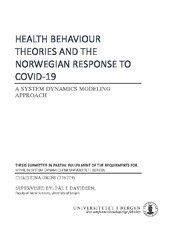Health Behaviour Theories and the Norwegian response to COVID-19: a System Dynamics Modeling approach
Master thesis
Permanent lenke
https://hdl.handle.net/1956/23665Utgivelsesdato
2020-08-12Metadata
Vis full innførselSamlinger
- Master theses [140]
Sammendrag
The aim of this work is to investigate the coupled dynamics between infection and behavioural response at the population level in the case of the novel Coronavirus 2019 (COVID-19) in Norway. For this purpose, a System Dynamics simulation model has been developed that proposes a number of modifications on classical differential equations epidemiological models to better apply in the case of COVID-19. Moreover, this work attempts to bring together well-establish theories under the umbrella term Health Behaviour Theories that investigate the response of individuals to environmental threats to their well-being. We have tested both components of the model in isolation and combination and were able to replicate, with a sufficient degree of accuracy and under logical assumptions, the observations of the spread of COVID-19 in the country. More importantly, we have developed a simulation model that captures numerous of the common elements identified in Health Behaviour Theories in one composite structure that can allow for experimentation with various assumptions. Our model highlights the importance of communication strategies in the management of environmental Threats and, in line with known theories, suggests that it is optimal to share messages that not only highlight the significance of the Threat, but also emphasise the Efficacy of a proposed behavioural response in mitigating it. Communication is important but we need to ensure that we minimize and understand the Costs associated with any proposed measure. Despite limitations in our work that do not allow us to propose specific policies for the management of COVID-19, our model suggest caution with “return-to-normal” scenarios. This work has provided support for the attempt to develop a common theoretical framework of peoples’ response to threats and provided with important focal points for further iterations. Those are considered significance due to their possible applications beyond COVID-19, both in other epidemiological contexts and health-related decision making, but also in the general understanding of peoples’ reaction to environmental Threats to their wellbeing
